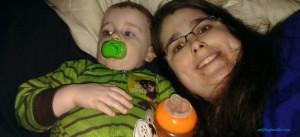
This morning my baby woke up with a fever and I knew that something was wrong since he just finished taking a round of antibiotics from his last illness less than two weeks ago. When I took his temperature this morning, it was 103 degree using a rectal thermometer. In the past, we have ran him to the doctor prematurely only to find out that there wasn’t anything wrong with him yet. My son’s pediatrician recommends waiting a few days to bring him in but my mommy instincts take over. I know when my baby doesn’t feel well and I usually take him into the doctor when I feel that it is appropriate.
Note: I am not a doctor, nurse, or health care provider. This post is for informational purposes only and never should replace getting your child medical treatment.
When to seek medical treatment for a fever?
A fever is usually the first sign or symptom that sends off alarms and makes parents know that something is wrong. Your child’s body may potentially be fighting off an infection or a virus, but it is important that you seek medical treatment. Infants and young children can get sick quickly and a fever can indicate an illness or even a serious illness. Contact your child’s doctor immediately for the following reasons; if necessary, seek medical treatment or call 911:
- A rectal temperature that is 100.4 degrees or higher in an infant that is younger than 3 months old needs to be evaluated, even if he or she doesn’t have any other symptoms or seem sick.
- A rectal temperature 101 degrees or higher in an infant that is between 3 to 6 months old needs to be evaluated, even if he or she doesn’t have any other symptoms or seem sick.
- A rectal temperature 102 degrees or higher in an infant that is 6 months and older that lasts longer than 2 days needs to be evaluated to ensure that they don’t have an infection or series illness.
- A rectal temperature 103 degrees or higher in an infant older than 6 months old needs to be evaluated, even if he or she doesn’t have any other symptoms or seem sick.
What Other Symptoms Should I Look for If My Infant/Toddler has a Fever?
If your child has any of the following symptoms that accompany your child’s fever, you should contact your child’s doctor, urgent care center, or visit the emergency room as necessary:
- Vomiting
- Diarrhea
- Stomach Pain
- Dry Mouth
- Excessive Drooling
- Earache or Tugging/Pulling on Ears
- Fever That Lasts For Several Days
- High-Pitched Crying
- Excessive Crying or Inconsolable
- Irritable
- Headache
- Seizures (Shaking Uncontrollably)
- Sore Throat
- Stiff Neck
- Poor Appetite
- Pale
- Rash on the Skin
- Sore/Achy or Swollen Joints
- Soft Spot on an Infant that Appears Swollen
- Unresponsive or Listless
- Wheezing, Rattle in Chest, or Coughing Fits
- Whimpering
A young child may not be able to tell you if they don’t feel good, so it is important that you monitor their symptoms. If your child has a fever, make sure that your child is getting enough liquids to prevent dehydration.
What is the Best Way to Take My Child’s Temperature?
Taking your infant or toddler’s temperature can be a challenge, but it is important that you get your child’s accurate temperature so that you can relay this information to your child’s doctor. A rectal temperature is the most accurate way to check your child’s temperature, especially, for a child that is less than three months old. Your pediatrician or doctor will use your child’s rectal temperature to determine how to treat your child’s fever.
- Rectally – This is the most accurate way to take your child’s temperature. Make sure that the thermometer is clean, using hot soapy water or alcohol. Mark all rectal thermometers so that it won’t be used in anyone’s mouth, even though it has been cleaned. Next, add a small amount of lube such as KY Jelly or Vaseline to the tip of the thermometer. Insert it into your child’s bottom carefully and never force it. The thermometer only needs to be inserted a half of an inch into your child’s bottom.
- Orally – Using an oral thermometer is best used for older children and adults. Clean the thermometer with soapy water or alcohol before using it. Then place it under your tongue. Make sure that you wait 20 to 30 minutes after eating or drinking to ensure that your temperature is accurate.
- Under the Arm – Taking your temperature under the arm, can be used to determine if you have a fever. Although, this is method isn’t as accurate; in fact, you have to add a degree to the temperature that is registered.
- Ear Thermometers – These thermometers are great and they allow you to take your child’s temperature quickly; however, if it isn’t used correctly you may not get an accurate reading. Never use an ear thermometer on a child that is younger than 6 months old, their ear canals are too small and narrow to get an accurate reading.
- Temporal Artery Thermometers – This is a fairly new thermometer and prove to be accurate. They shouldn’t be used on a child that is younger than 3 months old. Make sure to follow the manufacturer’s directions for accurate temperature results.
- Pacifier Thermometers – These seem great in theory since your baby loves to suck on a traditional pacifier. However, these thermometers aren’t very accurate or reliable. If you choose to use this type of thermometer, ensure that your child keeps it in his or her mouth for about three minutes and add a half a degree to get a more accurate result, since they tend to run a lower temperature compared to traditional oral reading.

